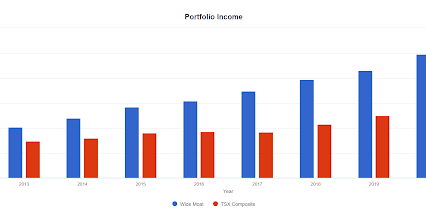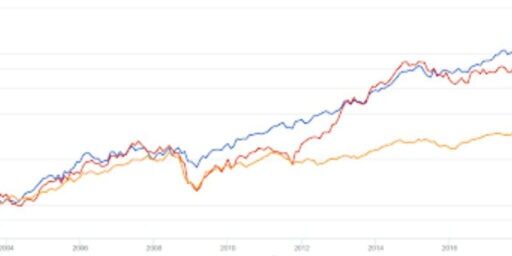Smith Manoeuvre Portfolio – May 2008
Time again for the monthly Smith Manoeuvre Portfolio update, May 2008 edition. I asked during the last update whether or not I should keep these monthly portfolio posts going, or if I should space them out a bit. I think that most of you enjoy these posts, but some may find them boring. So, I have decided that I will keep this post going providing that I have made changes to the portfolio during the month.
For those of you just joining us, The Smith Manoeuvre is a Canadian wealth strategy that utilizes a home equity loan to invest in income producing assets. The result is a tax deductible loan and portfolio that increases as you pay down your mortgage.
Onto the portfolio. It seems that this past month, the Canadian markets have taken off again and have even reached new highs. The new highs made by the index were mostly due to RIMM and POT and would have been even higher if the financials took off.
In terms of trading, there weren’t any new positions initiated, but there have been a few additions to existing holdings RY, PWF, MFC, TRP
| Stock | Symbol | Shares | Avg Buy Price | Total | Div/Share | Avg Yield |
| Royal Bank | RY.T | 75 | $47.62 | $3,571.25 | $2 | 4.20% |
| CIBC | CM.T | 45 | $67.14 | $3,021.25 | $3.48 | 5.18% |
| Power Financial | PWF.T | 75 | $35.68 | $2,675.75 | $1.25 | 3.50% |
| Scotia Bank | BNS.T | 25 | $44.85 | $1,121.25 | $1.88 | 4.19% |
| Manulife Financial | MFC.T | 50 | $39.42 | $1,971.00 | $0.96 | 2.44% |
| Fortis Properties | FTS.T | 50 | $27.30 | $1,365.00 | $1 | 3.66% |
| TransCanada Corp | TRP.T | 50 | $36.87 | $1,843.25 | $1.44 | 3.91% |
Total Portfolio Cost Base: $15,568.75
Total Dividends / Year: $615.35
As you can see, the portfolio is still heavily concentrated in financials with a sprinkle of utilities. This lack of diversity is inevitable when investing in Canadian dividend paying stocks.
The stock that I currently have my eye on is AGF Management (T-AGF.B) which is a mutual funds management company and sports a current dividend yield of 4.50%. It is currently on the dividend achievers list with a stock price that seems to be beaten up. I’ll have to do more research as to why it “appears” so cheap. Anyone have any ideas?
I've Completed My Million Dollar Journey. Let Me Guide You Through Yours!
Sign up below to get a copy of our free eBook: Can I Retire Yet?










Market Lessons,
I think evaluating the SM based on less than 1 year of real life implementation is foolhardy, regardless of whether the market is up/down. If someone extolled the virtue of any investment (rather than speculative) strategy with only 12 months of data, hopefully there would be people out there skeptical enough to evaluate it over at least a 5 year time frame.
If you don’t have (as opposed to “think” you have) a tolerant for risk, a suitably long time frame and a plan that you commit to, then don’t even consider the SM.
No chip here. I’ve just heard too much BS through the years to fall for such a “strategy”. I know of people who are using this Smith Manoevre. You know, the ones with the long faces, ’cause they thought the sun was going to shine on their portfolios everyday. I guess its been “cloudy” these past few months…….
And the readvanceable mortgage you speak of is a big IF with a lot of people on the hook. You’re not breaking even if you’re down 20%! You still had to come up with the 20% in the first place, and if the market has wiped that out, you are down 20% ( a friends house is down 30%!!). That IS real money you know. As well, the above portfolio is down 29% in value as of Friday, and that’s with a recent spike in the markets. Hopefully, some more recovery is on the way over time. That’s why I hope everyone will reach age 150, so they can recover from this horrible market.
There are many, many better ways to make money in the market. It’s just a huge gamble to me (and this market is proof of that) that one would attempt to use this type of instrument. My guess is many “new” investors have gone with this type of strategy and are quite perplexed by how it is turning out for them.
I am reminded by some sage advice: “The only way to make money in the market, is to give advice about how to make money in the market”. The SM is just another cheery way to do this.
The Smith Manoeuvre is working just as its supposed to. Why would you think it would be any different these days?
I think it would be difficult to be upside down on your house value if you had a readvanceable mortgage. You can only get those for up to 80%LTV. Which means, worst case, you’d be breaking even if house prices when down 20% from when you bought.
So maybe lose the chip on your shoulder.
Gee, I wonder how the old Smith Manoeuvre is working these days? Nothing worse than being upside down on BOTH your house value and your borrowed against investment portfolio at the same time. Sweet dreams…………….
I have to chuckle each time someone comes out with a new way for people to part with their hard earned cash. Well, if we all live to be 150 years old, I guess we’ll be okay.
I thought I would add this site as a resource for further explanation on the Smith Manoeuvre. It has screen shots of example using the Smithman Calculator.
http://www.toronto-investment.ca
It’s interesting to see your div per year.
I am also doing this and am holding the following mutual funds:
DYN1031 5,055.20
RBF600 5,093.69
SAX347 5,308.38
SIC009 5,190.06
They are generating around $30+ a month each. Conservatively that’s $1,000 a year in dividends. Which I am rolling back into the funds as I really want to take advantage of the compounding.
My understanding of the SM was that at the end of 25 years you would still owe EXACTLY the price of your house on your mortgage, but you would have invested it all on the other. Compounding it would be worth WAY more than your house. Which doesn’t go with you moving the DIVs back to pay the interest.
The other thing I understood that we are both doing wrong is that you want to invest in things that DON’T trigger much (if any) interest or dividends. So you are able to write-off your interest payments BUT you only ever trigger capital gains in the end.
Has anyone seen this: http://www.upvest.com/
It is basically AIC (which has funds that do what I describe above) trying to push people to leverage, essentially the SM.
Please call me out if you think I’m full of it…
What is the home equity loan interest rate is right now? How much do they usually charge in terms of interest rate?
I like the idea of having the dividend pay the interest. however, did you consider what would be the difference if you would reinvest those dividends over a long period of time?
I think it would be a good idea to compare both situations, isn’t?
That would make an interesting comparison, might be an idea for a post. :) The way I see it is that if I use the dividends to pay down the mortgage, I can reborrow and reinvest the same amount anyways.
[…]Million Dollar Journey posted updates on his investing in Smith Manoeuvre Portfolio – May 2008[…]
If your predominant strategy is to hold long term then the share price movement after purchase does not matter much as it does not affect the yield off your original investment amount. We’re not buying dividend yielding stocks in order to buy low and sell high, we’re looking for solid dividend histories for future cash flow. In regards to my example of share price doubling, I was referring to a short term spike where dividend yields have not yet moved upwards. If we’re spreading this over several years, then yes, dividend yields would (or at least should) move accordingly… but the short term price spike will matter little to our valuation of our portfolio from a yield/cash flow perspective.
And you are right about the longer-term picture: As time moves on and yields increase, our return on original investment increases significantly. I am worried, however, that this past period of healthy dividend increases is coming to a close and we may be hitting a period of stagnant dividend growth.